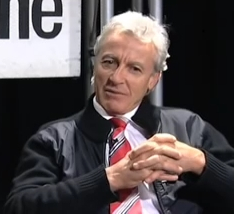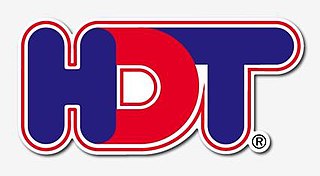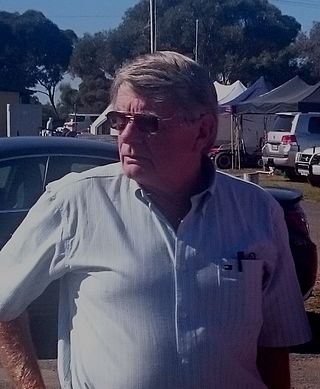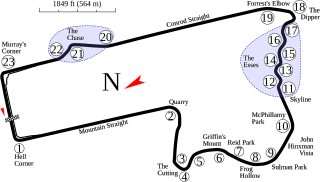
Peter Geoffrey Brock, known as "Peter Perfect", "The King of the Mountain", or simply "Brocky", was an Australian motor racing driver. Brock was most often associated with Holden for almost 40 years, although he raced vehicles of other manufacturers including BMW, Ford, Volvo, Porsche and Peugeot. He won the Bathurst 1000 endurance race nine times, the Sandown 500 touring car race nine times, the Australian Touring Car Championship three times, the Bathurst 24 Hour once and was inducted into the V8 Supercars Hall of Fame in 2001. Brock's business activities included the Holden Dealer Team (HDT) that produced Brock's racing machines as well as a number of modified high-performance road versions of his racing cars.

Jim Richards is a New Zealand racing driver who won numerous championships in his home country and in Australia. While now retired from professional racing, Richards continues to compete in the Touring Car Masters series.

The Holden Dealer Team (HDT) was Holden's semi-official racing team from 1969 until 1986, primarily contesting Australian Touring Car events but also rallying, rallycross and Sports Sedan races during the 1970s. From 1980 the Holden Dealer Team, by then under the ownership of Peter Brock, diversified into producing modified road-going Commodores and other Holden cars for selected dealers via HDT Special Vehicles.

Colin John Bond is an Australian former racing driver. Bond reached the highest levels in Australian motorsport in 1969 when he was recruited by Harry Firth to the newly formed Holden Dealer Team. He quickly found success, winning the 1969 Hardie-Ferodo 500 mile race at Bathurst, New South Wales in a Holden Monaro.

Garth Dirk Tander is a multiple-championship winning Australian motor racing driver competing in the Virgin Australia Supercars Championship's Enduro Cup, co-driving for Grove Racing. He was the 2007 series champion for the HSV Dealer Team and is a five-time winner in Australia's most prestigious motor race, the Bathurst 1000.
Garry Rogers Motorsport is an Australian motor racing team. It is owned by retired racing driver Garry Rogers who began the team to further his own racing efforts. Based in Melbourne, originally out of a Nissan dealership owned by Rogers, the team has competed in a variety of touring car series in Australia ranging from relatively modest Nissan production cars to Chevrolet NASCAR race cars to building the GT specification Holden Monaro 427C. The team won the Bathurst 1000 in 2000 and also won both of the Bathurst 24 Hour races which were held in 2002 and 2003. In 2013 the team celebrated its 50th year in racing since Rogers made his debut.
Bruce Alexander McPhee was an Australian motor racing driver. He is most famous for winning the 1968 Hardie-Ferodo 500, defeating both the Holden and Ford factory teams.

Neil Crompton is an Australian former racing driver, Supercars presenter and commentator.

The 1983 James Hardie 1000 was a motor race for Group C Touring Cars contested at the Mount Panorama Circuit, Bathurst, New South Wales, Australia on 2 October 1983. It was the 24th "Bathurst 1000" and the third to carry the James Hardie 1000 name. The race, which took place as part of Round 4 of the 1983 Australian Endurance Championship, was contested over 163 laps of the 6.172 km circuit, a total distance of 1006.036 km.

The 2002 Bathurst 24 Hour was an endurance motor race staged at the Mount Panorama Circuit just outside Bathurst in New South Wales, Australia. The race, which was the first 24-hour event to be held at Mount Panorama, started at 4:00pm on 16 November and finished at 4:00pm on 17 November. It was the first 24 Hour race to be held in Australia since the 1954 Mount Druitt 24 Hours Road Race.
Henry Leslie Firth was an Australian racing driver and team manager. Firth was a leading race and rally driver during the 1950s and 1960s and continued as an influential team manager with first the Ford works team and then the famed Holden Dealer Team (HDT) well into the 1970s. Firth’s nickname was "the fox", implying his use of cunning ploys as a team manager.
The Ford works team was the unofficial name for an Australian motor racing team which was supported by the Ford Motor Company of Australia. The team was formed in 1962 and was disbanded when Ford Australia withdrew from motor racing at the end of 1973. Drivers for the works team included Allan Moffat, Fred Gibson, Harry Firth, Bob Jane, Barry Seton, Bruce McPhee, John French, Ian Geoghegan and his brother Leo Geoghegan. Ford Australia also supported a factory rally team in Australia from 1977 to 1980.

The 1968 Hardie-Ferodo 500 was a production car race held on 6 October 1968 at the Mount Panorama Circuit just outside Bathurst in New South Wales, Australia. It was the ninth running of the Bathurst 500.
Norman Edward Beechey is a retired Australian race car driver, who was given the nickname "Stormin Norman" by his fans. To some, he was the closest thing Holden had to a star racing driver, before Peter Brock. Beechey competed in the Australian Touring Car Championship from 1963 to 1972 winning the title in 1965 driving a Ford Mustang and in 1970 at the wheel of a Holden Monaro. Along the way, he achieved seven round wins, and one pole position. His championship win in 1970 was the first victory by a Holden driver in the Australian Touring Car Championship.

Haldane George Reynolds was an Australian racing driver.
David McKay was an Australian journalist and prominent motoring identity.

Scuderia Veloce was an Australian motor racing team founded by journalist racer David McKay and his chief mechanic Bob Atkin. The team, which competed in many motor racing categories in the 1960s, is regarded as the first professional motor racing operation in Australia. It was based in Wahroonga on Sydney's upper North Shore. It later became a motor car dealership Specialising in Volvo, Porsche and Ferrari with Bob Atkin as the Managing Director.

The National Motor Racing Museum (NMRM) is located in the regional New South Wales city of Bathurst, approximately 200 km west of Sydney. The museum is situated adjacent to the Mount Panorama motor racing circuit at the end of Conrod Straight, close to the city.
Spencer John Martin is an Australian championship-winning racing driver. Martin's short career was highlighted by two Australian Drivers' Championship victories in 1966 and 1967, racing for Bob Jane Racing.

The Holden Monaro 427C was an Australian built and designed GT style race car based on the Holden Monaro CV8 road car. The car ran in the Procar Australia-run Australian Nations Cup Championship and at the short-lived Bathurst 24 Hour race at the famous Mount Panorama Circuit in Bathurst.












